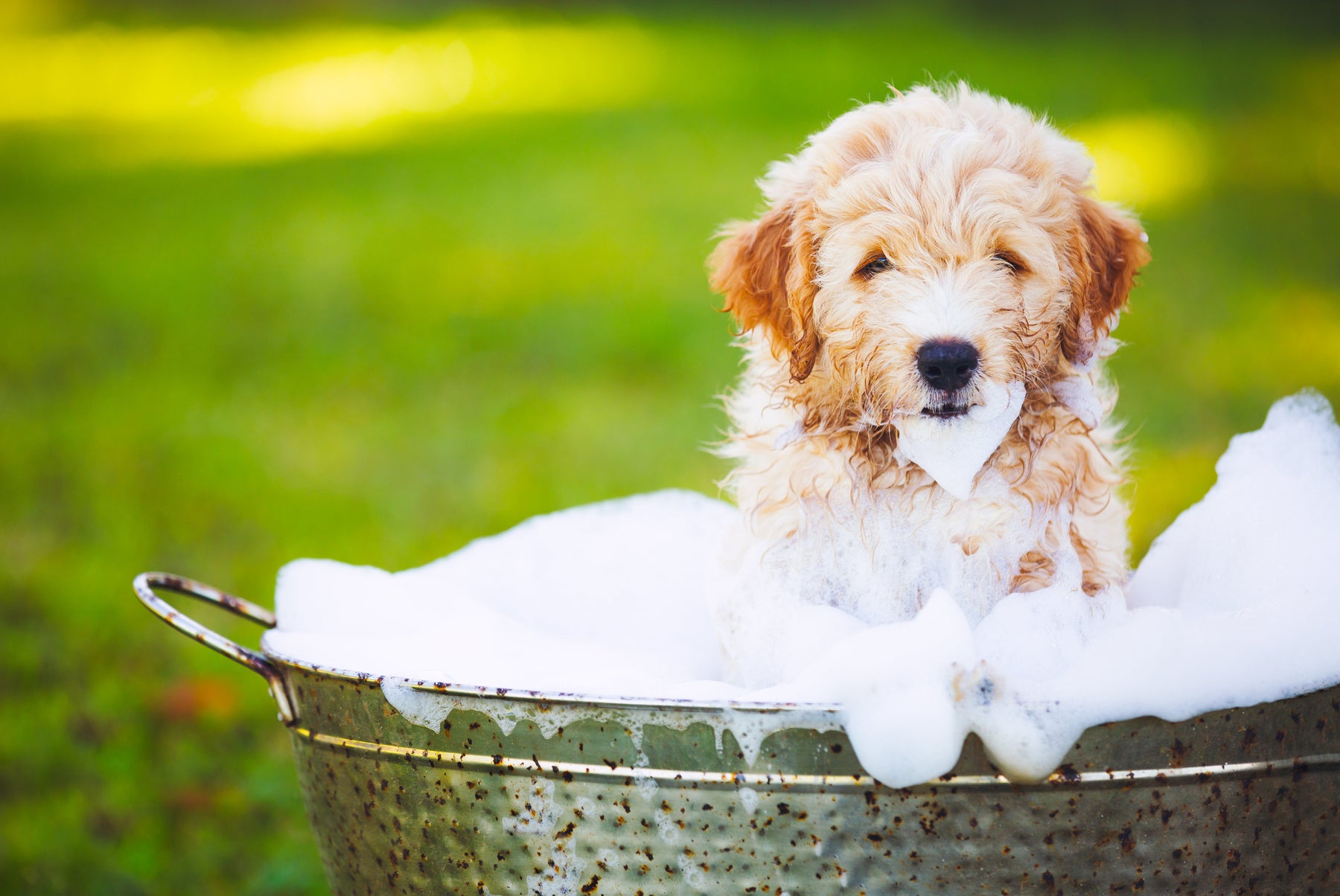
DISH SOAP AND THE COMPANION ANIMAL
We are often asked about the use of dish soap on pets for one reason or another. An email was received for me to review and investigate the ingredients to see if this mixture would be harmful if it was used on animals. The combination of the mixture in question is Ivory dish soap (25oz), water (25oz), and 1 cup (8oz) of Groomer’s Choice hair coat conditioner. The protocol at this salon is to use this mixture on every pet and to let the mixture set for 10 minutes to kill any fleas that may be present. With this all being stated I have researched all the ingredients and contacted the manufacturer of Ivory Dish Soap. I feel that my finding will be very helpful to many.

As I found on Procter & Gamble Co.’s own website, the manufacture of Ivory Dish Soap, they state that “Ivory soap is more caustic than some milder bars, such as Dove, a non-soap synthetic detergent bar.” It also went on to state that the pH has been determined to have a value of 9.5. (Caustic for both Human and Pets) Per their customer service department they stated to me that their Ivory Dish Soap was not safe for use on Pets and could be harmful if ingested and to contact poison control.
Ivory Dish Soap’s ingredients are as follows:
- Sodium Tallowate (Lye, is considered comedogenic-meaning tendency of substance to cause or worsen a buildup of dead cells in the follicle, leading to the development of a comedo or Blackhead) pH 13
- Sodium Cocate (A surfactant used as an emulsifying and cleansing agent primarily in bath soaps and cleansers)
- Water pH 7
- Sodium Chloride (Table Salt) pH~10
- Magnesium Sulfate (Epsom Salts) pH 6.0 (a drying agent, and used as a bulking agent) Groomer’s Choice Hair coat conditioner the information that I was able to find is as follows:
- Each gallon of concentrate yields 8 1 part conditioner to 7 parts water.
- pH of the concentrate is 8-7.0 (per MSDS)
- Ingredients were not available from the manufacturer, nor on the label or
What does all of this really mean? Well let’s start with the pH scale as a review.
PH Levels in pets Vs. Humans-
- Pets 0-7.52 (barrier zone)
- Humans 2-5.5 (acid mantle)
- The dog is the most alkaline of all species. Which make them the perfect breeding ground for bacteria a.k.a. skin infections if the epidermis is removed with a caustic product. Remember that the dog’s epidermis in only 8-10 cell layers thick!
When you move on the pH scale from one number to another it indicates a change of 10 times 10, or a 100-fold change. For example, if you went from 7 to 5 that is 200 times more acidic to the epidermis or 7 to 9.5 that would be 250 times more alkaline to the epidermis.
When the skin is exposed to low or high pH, inflammation can occur. Very strong acids, such as sulfuric acid, can produce chemical burns that basically destroy the epidermis in a human. Likewise, highly alkaline substances, such as Lye, can also produce inflammation and in some cases, chemical burns.
These acids/alkaline substances are, of course never used in esthetic services! Esthetics is a branch of anatomical science that deals with the overall health and well-being of the skin, the largest organ of the body.
“Iatrogenic” means you caused the problem on the pet’s skin with the bathing product/products that you choose to use. Always know what bathing products you are using and the benefits or damage they may cause. You the pet stylist are the one that is responsible for that pet. That pet is in your care and the choices that you make that day with your grooming products will result either in a healthy or damaged skin and hair coat. Furthermore, the resulting effect on the skin from using dangerously damaging products may not show up immediately, but the damaged skin may rear its ugly head weeks later. Of course, that is when the pet owner visits the veterinary office, and the veterinarian discovers the details of your bathing products and legitimately blames you for the damaged skin.
KNOWLEDGE IS YOUR FRIEND. KNOW YOUR PRODUCT INGREDIENTS.
With the mixture in question, the pH factor is 250 times too high to be used on the pet’s skin resulting in damage to the skin. What this very high alkaline mixture is doing is over drying and eroding the epidermis, which is the outer most layer of the skin, potentially causing dermatitis or infection. IT IS DOING NOTHING FOR KILLING THE FLEAS. Again, if the pet was to have a reaction to this mixture and was examined by the veterinarian with a diagnosis of skin disease caused by the groomer’s product, the groomer is liable for damages. V.P.I. (Veterinary Pet Insurance) will not pay for claims due to the fact
that a human product was used on a pet and that there was “off label use” of the product. The owner now has the right to come back on you, the groomer, to collect for damages including the veterinarian bill. AS A GROOMER, DON’T PUT YOURSELF IN A COMPOMISING POSITION BY USING POOR JUDGEMENT USING A MIXTURE OF DISH SOAP, WATER AND COAT CONDITIONER.
This mixture for flea control is clearly a poor choice. There are many other products that are safe and much more effective for flea control. One option is the use of a product called Capstar. It is inexpensive to purchase, acts quickly and the cost can be added into the grooming fee. It is legal for groomers to administer and sell.
The closer we get to licensure, the more educated we need to become. Ingredients are a vital part of what the bathing process is and that is where the groom starts….in the tub. That is also where the most damage is done to the skin and hair coat of the pet! The higher the quality of the ingredients you use in the bathing process the better the overall groom will be as well as the overall cost savings. A happier and healthier the pet, a happier client, equals return visits and more word-of-mouth business.


Human Skin Vs. Canine Skin
When you look at the diagrams of the human skin on the left and the canine skin on the right you should note one main difference, which is the size of the epidermis. In the Human it is approximately 18-20 cell layers thick and in the canine the epidermis is only 8-10 cell layers thick. The canine’s skin is thicker overall, but the epidermis is very thin and susceptible to bacteria if it is stripped away with improper ingredients that are not pH balanced for their skin. A good example is if you went to the salon for a facial you received a peel. What they did was removed several layers of your epidermis and the esthetician would send you home with product for after care and sun protection as well and specific instructions. A peel is also only done to help correct a specific skin problem; it is not an ongoing treatment unless you were under the care of a doctor. The same rules apply with a canine or a feline. The feline Epidermis is even thinner than the canine. There is no forgiveness with the feline epidermis. You may be able to get away with using this mixture of the Ivory Dish Soap, Water and Coat conditioner without serious damage to the skin once or twice but with repeated use you are looking for trouble.
As mentioned earlier most if not all the damage is done in the bathing and drying process. So, the better the ingredients the more time and energy you save. Human products should never be used on a pet. They are not pH balanced for their skin and can cause serious damage to the skin. You can be held liable for any medical problems that come from using that product. Remember the Manufacture of Ivory Dish Soap stated that it was not safe for use on pets.
We at Epi-Pet pride ourselves on helping educate the grooming community. We are not just a manufacturer we are an education company.
